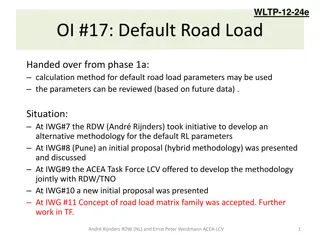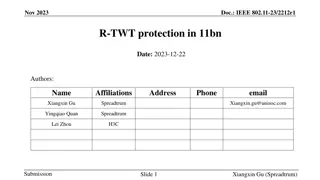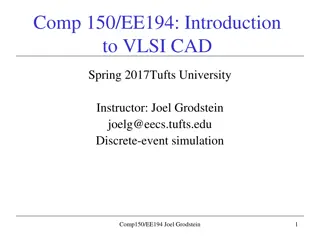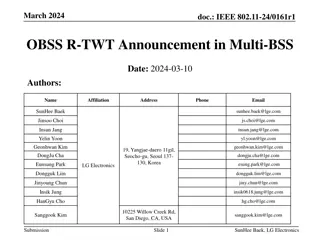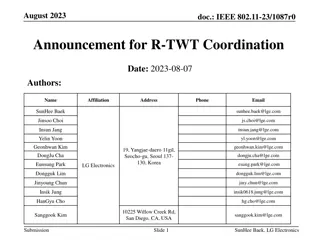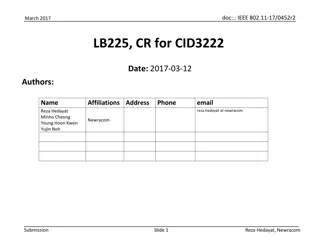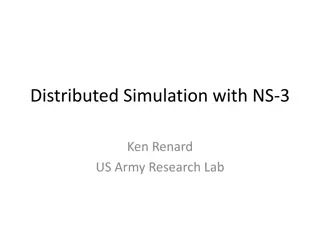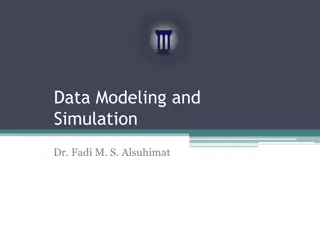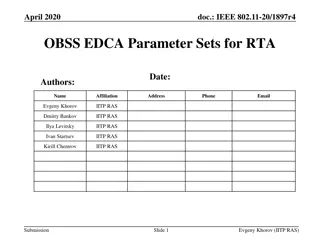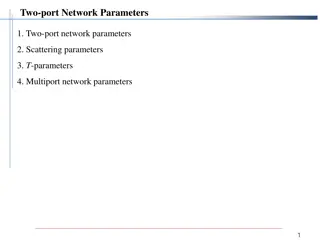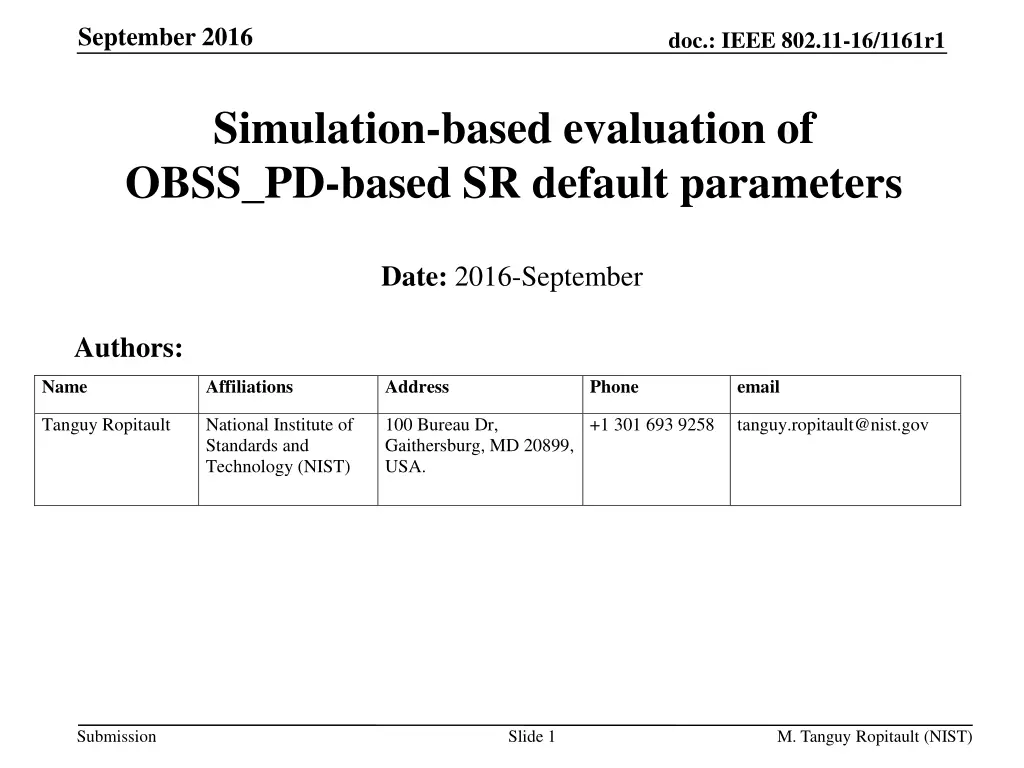
Evaluation of OBSS_PD-based SR Parameters in IEEE 802.11-16
Explore the simulation-based evaluation of OBSS_PD-based SR default parameters in IEEE 802.11-16 document from September 2016. The study investigates performance, proposes a method to compute OBSS_PDThreshold, and highlights trade-offs between throughput and fairness in wireless communication scenarios.
Download Presentation

Please find below an Image/Link to download the presentation.
The content on the website is provided AS IS for your information and personal use only. It may not be sold, licensed, or shared on other websites without obtaining consent from the author. If you encounter any issues during the download, it is possible that the publisher has removed the file from their server.
You are allowed to download the files provided on this website for personal or commercial use, subject to the condition that they are used lawfully. All files are the property of their respective owners.
The content on the website is provided AS IS for your information and personal use only. It may not be sold, licensed, or shared on other websites without obtaining consent from the author.
E N D
Presentation Transcript
September 2016 doc.: IEEE 802.11-16/1161r1 Simulation-based evaluation of OBSS_PD-based SR default parameters Date: 2016-September Authors: Name Affiliations Address Phone email Tanguy Ropitault National Institute of Standards and Technology (NIST) 100 Bureau Dr, Gaithersburg, MD 20899, USA. +1 301 693 9258 tanguy.ropitault@nist.gov Submission Slide 1 M. Tanguy Ropitault (NIST)
September 2016 doc.: IEEE 802.11-16/1161r1 1. Context OBSS_PD-based-SR Increase SR by using OBSS_PD i.e.: For an intra-BSS PPDU, keep using the legacy threshold For an inter-BSS PPDU, use OBSS_PD threshold (OBSS_PDThreshold) generally higher At the same time, the transmission power (TX_PWR) is adjusted for even greater SR [1] proposed default parameters for OBSS_PD-based SR In this submission we, Investigate the performances of OBSS_PD-based SR default values for the reference scenario used to test SR [2] and for the enterprise scenario [3] Propose a simple method to compute OBSS_PDThreshold based on beacon RSSI Highlight the fact that there is trade-off between maximum throughput reachable and fairness Submission Slide 2 M. Tanguy Ropitault (NIST)
September 2016 doc.: IEEE 802.11-16/1161r1 2. OBSS_PD-based SR mode How does it work? Proportional rule between TX_PWR and OBSS_PDThreshold and boundaries Minimum OBSS_PDThreshold_min OBSS_PDThreshold_max Maximum OBSS_PDThreshold= max min OBSS_PDThreshold_min+ (TX_PWRref TX_PWR) Adaptation zone [1] sets the following default parameters for 80MHz - OBSS_PDThreshold_min = -76dBm - OBSS_PDThreshold_max = -56dBm - TX_PWRref = 23dBm TX_PWR = TX_PWRRef (OBSS_PDThreshold OBSS_PDThreshold_min) OBSS_PDThreshold and TX_PWR computed -50 0 5 10 15 20 25 30 OBSS_PDThreshold_max -55 OBSS_PDThreshold (dBm) -60 -65 -70 OBSS_PDThreshold_min Zone 1 -75 Zone 2 Zone 3 -80 TX_PWR (dBm) Submission Slide 3 M. Tanguy Ropitault (NIST)
September 2016 doc.: IEEE 802.11-16/1161r1 3. Reference scenario (1/3) Topology STA1 STA3 BSS1 BSS2 3m 3m 30m AP1 AP2 STA4 STA2 Main parameters STAs send UDP traffic to their AP in saturation condition MCS used for transmission is fixed to 5 (around 200Mbps) OBSS_PD-based SR: Na ve approach => Vary TX_PWR (and thus OBSS_PDThreshold) from 1 to 21dB Measure BSSs aggregated throughput (throughput observed at AP1+AP2) Simulator: ns-3 Goals Check on a simple scenario if OBSS_PD-based SR allows to increase SR Check if OBSS_PD-based SR boundaries (OBSS_PDThreshold_min and OBSS_PDThreshold_max) fits to the reference scenario Submission Slide 4 M. Tanguy Ropitault (NIST)
September 2016 doc.: IEEE 802.11-16/1161r1 3. Reference scenario (2/3) Results BSSs throughput vs TX_PWR 450 Zone 1 Zone 2 Zone 3 400 BSSs throughput (Mbps) 350 300 250 200 150 100 50 0 0 5 10 15 20 25 TX_PWR (dBm) Observation Zone 1: No throughput TX_PWR used is too weak for allowing frame to be decoded Zone 2: BSSs throughput is almost twice than the MCS throughput Both BSS are able to transmit at the same time Increase of SR Zone 3: BSSs throughput is equal to MCS throughput No Increase of SR Boundaries: OBSS_PDThreshold_max = -56dBm which corresponds to a TX_PWR of 3dBm and reference scenario configures STA to transmit with 15dBm => OBSS_PD-based SR corresponds to zone 2 Conclusions OBSS_PD-based SR allows SR increase and default parameters work fine for the reference scenario Reference scenario = Simple symmetric scenario => Na ve approach: Use the same TX_PWR for all STAs More complex scenarios: Need to have a method to dynamically adapt to the network conditions Submission Slide 5 M. Tanguy Ropitault (NIST)
September 2016 doc.: IEEE 802.11-16/1161r1 4. OBSS_PDThreshold or TX_PWR? We have the relationship between OBSS_PDThreshold and TX_PWR are but one is needed to compute the other How to obtain one of them and which one to use is implementation dependent In this submission, we define a simple method to obtain OBSS_PDThreshold How to obtain OBSS_PDThreshold? Use of a margin OBSS_PDmargin When receiving a beacon, a STA keeps its RSSI and compute OBSS_PDThreshold in the following way: OBSS_PDThreshold = BeaconRSSI OBSS_PDmargin Then, compute the associated TX_PWR Submission Slide 6 M. Tanguy Ropitault (NIST)
September 2016 doc.: IEEE 802.11-16/1161r1 5. Enterprise scenario (1/6) Topology Single floor office building, 8 offices: 4 APs per office i.e. 32 APs 64 cubicles per office Each cubicle has 4 STAs so 8*64*4 = 2048 STAs 2 m 20 m STA1 STA4 20 m 2 m BSS9-12 BSS13-16 BSS24-28 BSS29-32 STA2 STA3 1 Cubicle = 4 STAs BSS1-4 BSS5-8 BSS17-19 BSS20-23 8 offices 1 Office = 64 cubicles Submission Slide 7 M. Tanguy Ropitault (NIST)
September 2016 doc.: IEEE 802.11-16/1161r1 5. Enterprise scenario (2/6) Channel allocation: 5GHz Four 80MHz channels (Ch1 to Ch4) AP Channel 1 2 3 4 Main parameters STAs send UDP traffic to their AP in saturation condition MCS used for transmission is fixed to 5 (around 200Mbps) Four 80MHz channels Submission Slide 8 M. Tanguy Ropitault (NIST)
September 2016 doc.: IEEE 802.11-16/1161r1 5. Enterprise scenario (3/6) Results: Throughput Aggregated Throughput vs OBSS_PDMargin Zone 1 Zone 2 Per-Sta Average Throughput and 5th percentile CDF throughput 3500 Zone 3 Zone 1 Zone 2 Zone 3 1.6 3000 1.4 Throughput (Mbps) Throughput (Mbps) 2500 1.2 1 2000 0.8 1500 0.6 1000 0.4 0.2 500 0 0 10 11 12 13 14 15 16 17 18 19 20 21 22 23 24 25 26 27 28 29 30 31 32 8 9 Legacy 10 11 12 13 14 15 16 17 18 19 20 21 22 23 24 25 26 27 28 29 30 31 32 8 9 Legacy OBSS_PDMargin OBSS_PDMargin Default 5th percentile Default Average Observations 3 zones Zone 1: Aggregated throughput is less than the legacy one (around 30% of decrease) => TX_PWR computed is too weak for furthest away STAs Confirmed by the 5th percentile throughput result Zone 2: Increase of aggregated throughput around 55% - 5th percentile throughput per STA is close to the average per STA (20% of difference) Zone 3: Increase of aggregated throughput up to 80% - However, 5th percentile throughput results tend to be very different from the average per STA one (up to 74% of difference) Conclusions OBSS_PDMargin highly affects OBSS_PD-based SR performances OBSS_PD-based SR default values allow to increase aggregated throughput and to obtain a good fairness Submission Slide 9 M. Tanguy Ropitault (NIST)
September 2016 doc.: IEEE 802.11-16/1161r1 5. Enterprise scenario (4/6) How is materialized concretely every zone? Goodput Ratio Goodput ratio GR: STA Goodput Ratio: GRi = #APUDPReceivedi / #STAUDPSenti Per-Sta Average Throughput and 5th percentile CDF throughput 2 Zone 1 Zone 2 Zone 3 Throughput (Mbps) 1.5 1 0.5 0 OBSS_PD margin Observations: Conclusion: Zone 1: Either a GR ratio of 1 or 0 => System is unfair Zone 2: Very homogenous GR (between 0.35 and 0.55) All STA are experiencing the same fairness => System is fair Zone 3: Very heterogeneous GR with some STA experiencing a GR close to 0 while others are close to 0.9 => System is unfair Best margin values depend from the objective: for best fairness, an OBSS_PDMargin between 16 and 20dBm is recommended Submission Slide 10 M. Tanguy Ropitault (NIST)
September 2016 doc.: IEEE 802.11-16/1161r1 5. Enterprise scenario (5/6) OBSS_PD-based SR is working [1] is proposing to use different OBSS_PDTreshold_min Test -72, -69 and -66 values Results for aggregated throughput 3500 Best aggregated throughput 3000 2500 Aggregated Throughput Default 2000 72 69 1500 66 1000 500 0 8 9 10 11 12 13 14 15 16 17 18 19 20 21 22 23 24 25 26 27 28 29 30 31 32 Observation Changing OBSS_PDThreshold_min does not allow to increase maximum aggregated throughput It may gives better results for fairness? Submission Slide 11 M. Tanguy Ropitault (NIST)
September 2016 doc.: IEEE 802.11-16/1161r1 5. Enterprise scenario (6/6) Results for throughput per STA 1.6 1.4 1.2 1 0.8 0.6 0.4 0.2 0 8 9 10 11 12 13 14 15 16 17 18 19 20 21 22 23 24 25 26 27 28 29 30 31 32 Default 5th percentile Default Average 72 5th percentile 72 average 69 5th percentile 69 average 66 5th percentile 66 average Observation Changing OBSS_PDThreshold_min does not allow to to obtain better throughput per STA/5th percentile throughput Conclusion OBSS_PD-SR based default value for OBSS_PDThreshold_Min value seems to be optimal for enterprise scenario in order to obtain the best throughput/fairness ratio Submission Slide 12 M. Tanguy Ropitault (NIST)
September 2016 doc.: IEEE 802.11-16/1161r1 6. Conclusions/next steps Preliminary results for OBSS_PD-based SR OBSS_PD-based SR works and default parameters seem correct for both SR and enterprise scenario. Simple method to compute OBSS_PDThreshold Parametrization is of crucial importance: A margin between 16 and 20 dBm is recommended Could be improved in many ways to obtain better results (cross-layer information such as ETX, or MCS) Compute the TX_PWR based on the network conditions instead of OBSS_PDThreshold Submission Slide 13 M. Tanguy Ropitault (NIST)
September 2016 doc.: IEEE 802.11-16/1161r1 7. References 1) Laurent Cariou et al., 11-16-0945-01 Clarification for OBSS_PD-based SR parameters 2) Masahito Mori et al., 11-15-0801-00 DCCA/DSC Reference Simulation Results Improvements with Channel selection and Dynamic Sensitivity Control 3) TGax group, 11-14-0980-16 TGax Simulation Scenarios Submission Slide 14 M. Tanguy Ropitault (NIST)
September 2016 doc.: IEEE 802.11-16/1161r1 8. Annex Submission Slide 15 M. Tanguy Ropitault (NIST)
September 2016 doc.: IEEE 802.11-16/1161r1 Reference scenario Results BSS throughput vs TX_PWR 450 Zone 1 Zone 2 Zone 3 400 BSSs throughput (Mbps) 350 300 250 200 150 100 50 0 0 5 10 15 20 25 TX_PWR (dBm) Why Zone 2 and 3 are happening? Why Zone 1 is happening? 0 0 5 Channel sensed Free 10 15 20 25 -10 0 Channel sensed Busy 1 2 3 4 5 6 7 8 9 10 11 12 13 14 15 16 17 18 19 20 21 -20 -10 -30 Power (dBm) -20 Power (dBm) -40 -30 RX_PWR is becoming higher than OBSS_PDThreshold -50 -40 -60 -50 -70 -60 RX sensitivity is reached when the STA is transmitting with a TX_PWR >= 3dBm -80 -70 -90 TX_PWR (dBm) TX_PWR (dBm) RX_PWR at AP when a STA sends to its AP AP RX sensitivity (-56dBm) Reception power when STA from one BSS transmit to STA in the other BSS OBSS_PDThresold Submission Slide 16 M. Tanguy Ropitault (NIST)
September 2016 doc.: IEEE 802.11-16/1161r1 Enterprise scenario parameters Parameters Values Traffic type UDP CBR uplink transmissions in saturation conditions 1538 Bytes (from SSD) (1544 Bytes in total incl. all overhead) MPDU size Aggregation: 32 MPDUs with 4-byte MPDU delimiter per A- MPDU No A-MSDU Implicit immediate BA Aggregation PPDU of Data frame VHT PPDU (MCS 5, fixed) Guard Interval Short - OBSS_PDThreshold_min = -76dBm - OBSS_PDThreshold_max = -56dBm - TX_PWRref = 23dBm OBSS_PD-based SR Simulator ns-3 Submission Slide 17 M. Tanguy Ropitault (NIST)
September 2016 doc.: IEEE 802.11-16/1161r1 Influence of the margin? Small margin values result in having furthest away node with a high OBSS_PDThreshold i.e. OBSS_PDThreshold_maxand thus the minimum allowed transmission power (risky?) High margin results in closest nodes having the smallest OBSS_PDThreshold i.e. OBSS_PDThreshold_minand thus the maximum allowed transmission power (not efficient?) A good margin value is probably in-between Try to find the optimal margin value for the enterprise scenario Submission Slide 18 M. Tanguy Ropitault (NIST)


